Triple Down with Marketing: Team. Talent. Technology.
There’s no better time to build businesses than right now. We have the technology to transport our  message to exactly the right audience at exactly the right time. Marketing processes can be automated, sales cycles can be easily influenced, and data can be analyzed to bring us the edge needed over the vast array of competitors. However, we still need the strategy, skill, and savvy brains behind any of these operations for them to work.
message to exactly the right audience at exactly the right time. Marketing processes can be automated, sales cycles can be easily influenced, and data can be analyzed to bring us the edge needed over the vast array of competitors. However, we still need the strategy, skill, and savvy brains behind any of these operations for them to work.
“Market like the year you live in,” as often said by Gary Vaynerchuk, means embracing all avenues available to a modern marketing organization. It means being relevant in both the messages as well as the channels in which you communicate them. Sounds logical. How, though, does this perfect storm of factors look like for most B2B companies? And how is it made sustainable to grow with the changing demand of customers—and the change in years?
Team
“Great things in business are never done by one person. They’re done by a team of people.” – Steve Jobs
The alignment of marketing, business development, and sales departments is a vital factor in the success of a modern organization. While this point is rarely disputed, putting it into practice, particularly in older and more complex companies, is not always straightforward. To be successful, corporations with more rigid structures in place will have to focus on the roles and focus areas within a marketing team. Companies in the early stages of maturity have the benefit of putting together the marketing team from scratch in close collaboration with other core areas, focusing on internal communication paths, joint KPIs and the data needed to track results.
An ideal example involves a Chief Growth Officer or Chief Commercial Officers, at the helm of both marketing and sales, and often product and innovation teams. Leaders in these roles have seamless interaction and concise messaging and vision at the top of their list of priorities, laddering up to continuous revenue improvements.
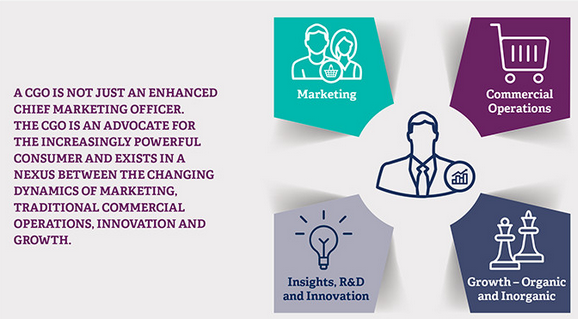
What happens within the teams, though? What key functions does a modern marketing team need to do more than just float in a sea of opportunity?
Tips to form the ultimate marketing crew:
-
Reverse engineer: work backward from your business goals to identify what campaigns and the journey you are trying to create
-
Determine which roles are needed to roll those multi-touch campaigns out initially and then scale them (e.g., consider localization support, in-country field marketing managers)
-
Consider core management roles integral to any multi-touch campaign: brand, content creation, Ideal Customer Profile & customer experience ownership, ABM, paid & unpaid advertising, event marketing, website, PR, MarTech, social media, channel partners, marketing automation/marketing ops & performance, telemarketing
-
Be more strategic with how you support the Bottom of the Funnel (BOFU) stage of marketing collaborate closely with inside sales and marketing ops/sales ops functions (e.g., use data and team feedback to perfect account-based marketing (ABM) campaigns)
-
Consider a Performance Revenue Operations team, sharing technology and manpower across marketing and sales in order to use data to finetune activities throughout the buyer’s journey
Based on marketing budget and resource constraints, strongly consider outsourcing some areas to a B2B Marketing as a Service (MaaS) vendor, ensuring that strategic and brand ownership remains in-house.
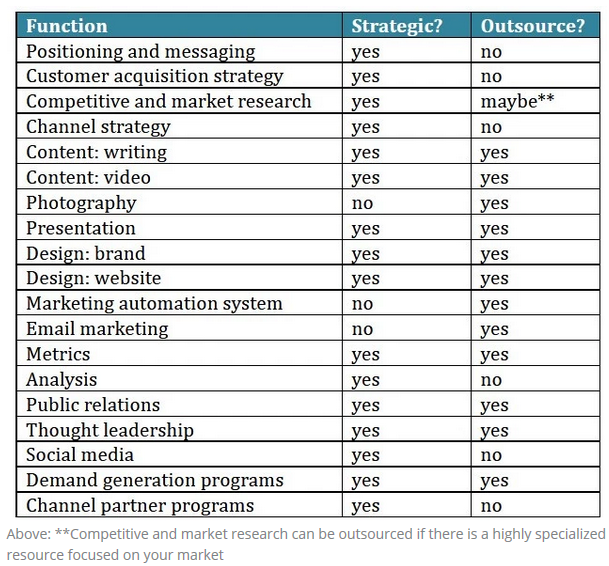
By 2020, the majority of marketing teams should have a new structure in which the focus is to drive strategy, revenue, and customer experience and engagement.
Talent
“Please stop waiting for a map. We reward those who draw maps, not those who follow them.”—Seth Godin
The skills a marketer should possess varies, depending on who you ask.
Chat to your Sales Director—they’ll say things like, “marketing needs to be more data-savvy” or, “modern marketers need to have a sense for sales and understand what influences closed won opportunities.” Chat to your Customer Success team—they’ll happily suggest a marketer “needs to focus more on existing customers and upselling” or “educational content and events to keep customers happy and loyal.”
With so many different priorities and opinions, we can, however, sum up what a modern marketer should have inherently vs. what they can acquire or learn.
Based on a 2018 study, Gartner has determined some key competencies successful marketers need:
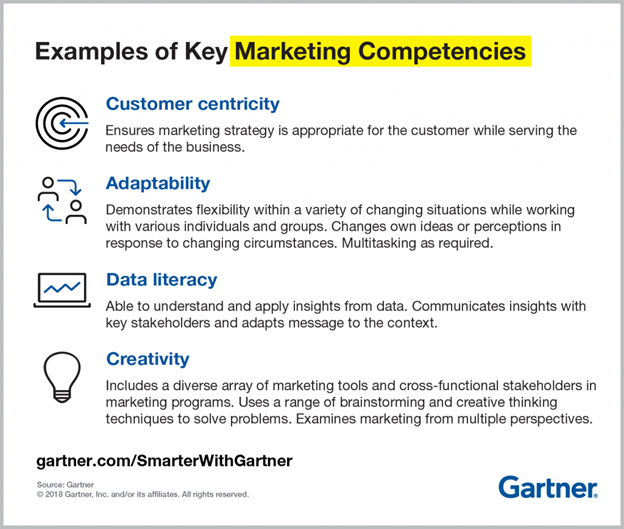
The perfect combination is, of course, a mix of creativity, analytical thinking, and proactive behavior—embracing calculated risks.
A healthy dose of curiosity, stakeholder management, and communication skills and agility have, from experience, shown themselves to be the driving forces behind any marketer that continues to evolve and significantly contribute to the success and bottom line of a business.
Technology
The struggle between marketing and IT teams has improved in recent years, thanks to the technical understanding that modern marketing managers must have, as well as an understanding of the tech landscape within their companies. The importance of transparency and alignment with their CIO’s team is also top of mind.
Anthony Kennada, Vice-President of Marketing for US-headquartered customer success technology firm Gainsight, says the ‘chief marketing officer as the new chief information officer’ trend is driving change to how marketing teams are being structured. Companies that are able to make sense of this data in aggregate have a leg up on understanding the context behind each customer and predicting future behaviors. This has led to the rise of account-based marketing and one-to-many customer marketing.
With responsibility for technology and data-driven insights comes the necessary budget. According to Gartner, marketing technology (MarTech) budget has never been higher, coming in at 29% on average in 2018.
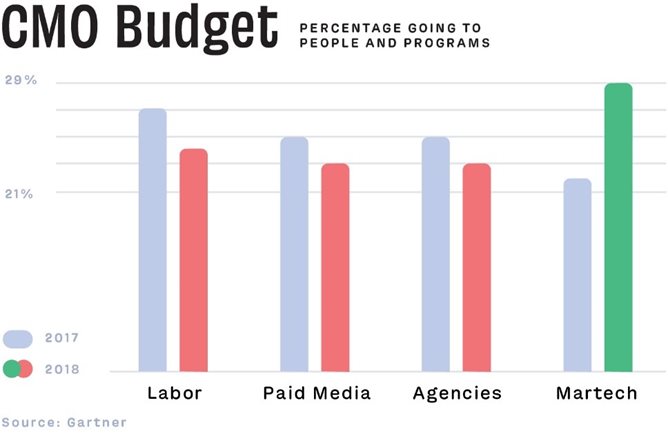
How can a modern marketing team decide on the right technology? Ideally, tools should link back to the core stages of:
- Attract
- Engage & Convert
- Analyze & Optimize
So, what MarTech tools are out there? Oh, just some of these:
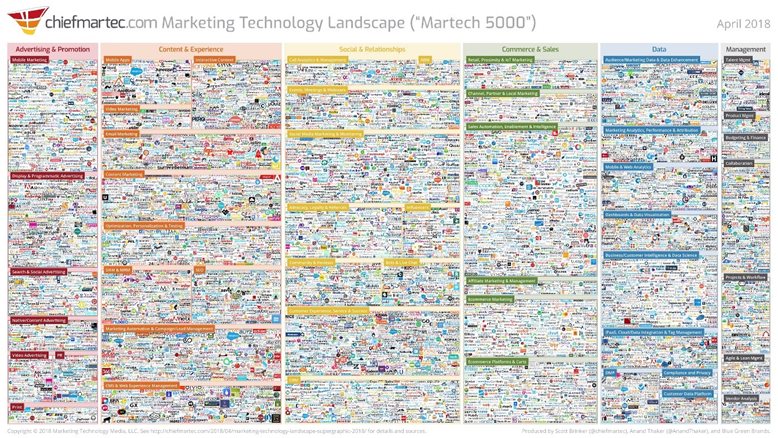
Hence, it’s best to stick to the core stages.
A good example by Kevin White of Segment shows how tools such as LinkedIn for attraction, Marketo for engagement, and Google Analytics are just a few options in making the most of a modern tech stack.
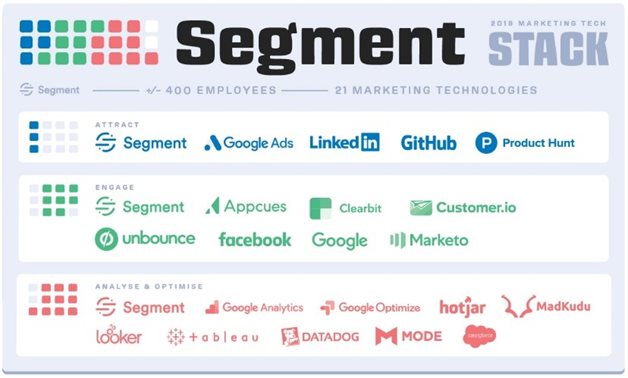
Integration between these tools is also important—the more of a “single source of truth” a marketing team can build, the less time will be spent still pulling data out of various systems and cobbling a half-coherent conclusion together in an Excel spreadsheet.
Vision without Execution = Hallucination
Collectively mapping out the long-term business goals in relation to multi-touch marketing campaigns and consistent messaging is a great start in the last quarter of a business year. Lining up the KPIs to tangible tactics within the campaigns, and then relating these to required technology will support the argument for more budget or support. Necessary hiring for both internal and external marketing pros also becomes clearer.
Then, equipped with the right team, talent and technology, a modern marketing organization’s rise to fame and fortune hinges on just one more final aspect—the ability to execute.

Janine Olariu
Janine is a marketing and sales professional based in Dublin, Ireland, with a history of director roles at SaaS, FinTech and social media companies across Europe. With over 10 years in strategic B2B marketing roles, Janine enjoys sharing her experiences and best practices on demand generation, the customer buying journey and marketing-influenced deal acceleration throughout the sales cycle.